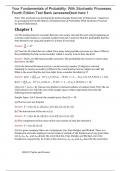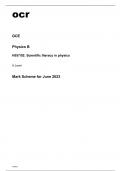Your Fundamentals of Probability: With Stochastic Processes,
Fourth Edition Test Bank (answered)text here 1
Note: This test bank was developed by Joshua Stangle (University of Wisconsin – Superior)
to accompany the fourth edition of Fundamentals of Probability: With Stochastic Processes
by Saeed Ghahramani.
Chapter 1
(1) The waiting time (in seconds) between one song’s end and the next song’s beginning on
a certain radio station is a random number between 3 and 6.8. Find the probability that the
time between one song and another is at least 4.9 seconds.
1.8
Answer: = .47
3.8
(2) Two fair 20-sided dice are rolled. How many total possible outcomes are there? What is
the probability that the second number rolled is exactly 4 more than the first?
Answer: There are 400 total possible outcomes. The probability the second is 4 more than
the first is 16/400.
(3) At the Internal Revenue Service, a social security number (9-digits) is selected
randomly to receive an audit. (a) What is the event that the last two digits are odd? (b)
What is the event that the last two digits form a number divisible by 5?
Answer: (a) 𝐸 = {∑8𝑖=0 𝑎𝑖 ⋅ 10𝑖 | 𝑎𝑖 ∈ {0,1,2, … ,9} for 𝑖 = 2, … , 8, 𝑎𝑗 ∈ {1,3,5,7,9} for 𝑗 = 0,1}.
(b) 𝐸 = {∑8𝑖=0 𝑎𝑖 ⋅ 10𝑖 | 𝑎𝑖 ∈ {0,1,2, … ,9} for 𝑖 = 1, … ,8, 𝑎𝑗 ∈ {0,5} for 𝑗 = 0}.
(4) Let 𝛺 = {𝑎, 𝑏, 𝑐, 𝑑}. Choose two distinct 2-element subsets at random from 𝑃(𝛺), the set
of all subsets of 𝛺. Find the size of the sample space of this experiment. Describe the
following events explicitly:
Sample Space: Let 𝑆 denote the sample space, then |𝑆| = 30.
(a) The two sets are disjoint.
Answer: 𝐸 = {{{𝑎, 𝑏}, {𝑐, 𝑑}}, {{𝑎, 𝑐}, {𝑏, 𝑑}}, {{𝑎, 𝑑}, {𝑏, 𝑐}}}
(b) The intersection of the sets is {𝑎}.
Answer: 𝐹 = {{{𝑎, 𝑏}, {𝑎, 𝑑}}, {{𝑎, 𝑐}, {𝑎, 𝑑}}, {{𝑎, 𝑏}, {𝑎, 𝑐}}}
(c) The complement of the union of the sets consists of only the element 𝑑.
Answer: 𝐺 = {{𝑎, 𝑏}, {𝑏, 𝑐}}
(5) At a given company there are 4 employees: Jim, Pam Dwight, and Michael. There is a
breakroom and each employee can be inside or outside of the breakroom at any given time.
Let 𝐴𝐽 , 𝐴𝑃 , 𝐴𝐷 , and 𝐴𝑀 denote the event that Jim, Pam, Dwight, and Michael are in the
breakroom, respectively. In terms of the events 𝐴𝐽 , 𝐴𝑃 , 𝐴𝐷 , and 𝐴𝑀, describe the event that
©2019, Taylor and Francis
,at most two people are in the breakroom at a given time. What about the event that at least
three people are in the breakroom?
Answer: The event that at most two people are in the room at the same time is
(𝐴𝐽 ∩ 𝐴𝑃 ∩ 𝐴𝐷 )𝐶 ∪ (𝐴𝑃 ∩ 𝐴𝐷 ∩ 𝐴𝑀 )𝐶 ∪ (𝐴𝐽 ∩ 𝐴𝑃 ∩ 𝐴𝑀 )𝐶 ∪ (𝐴𝐽 ∩ 𝐴𝐷 ∩ 𝐴𝑀 )𝐶
The event that at least 3 people are in the breakroom is
(𝐴𝐽 ∩ 𝐴𝑃 ∩ 𝐴𝐷 ) ∪ (𝐴𝑃 ∩ 𝐴𝐷 ∩ 𝐴𝑀 ) ∪ (𝐴𝐽 ∩ 𝐴𝑃 ∩ 𝐴𝑀 ) ∪ (𝐴𝐽 ∩ 𝐴𝐷 ∩ 𝐴𝑀 ).
(6) George likes antiques. He purchases an antique chair for $200 and plans to refurbish it.
Give an explicit sample space for the resale value of his chair after he refurbishes it. Define,
in set notation, the event that he loses money on his chair. Suppose George will only charge
whole dollar amounts for convenience.
Answer: The sample space for the value of his chair is 𝑆 = {0,1,2,3, … }. The event he loses
money is 𝐸 = {0,1, … ,199}.
(7) Suppose we have a sample space 𝛺 and two events 𝐴 and 𝐵. Suppose 𝐴 ⊂ 𝐵. Which
statement is false? Show a counterexample for your answer.
(a) 𝐵 cannot occur unless 𝐴 has occurred.
(b) 𝐴 cannot occur unless 𝐵 has occurred.
Answer: (a) Is false. Let 𝛺 = {1,2,3,4,5}, 𝐴 = {1,2,3} and 𝐵 = {1,2,3,4}. Then if the
experiment turns up 4, 𝐵 has occurred without 𝐴 occurring.
(8) At a certain ice cream parlor, 40% of patrons get hot fudge, 25% do not get whipped
cream, and 30% of patrons get both hot fudge and whipped cream. How many get hot fudge
or whipped cream.
Answer: 35%
(9) A fair (6-sided) die is rolled until the first time two even numbers are rolled in a row.
Give 10 elements of the sample space.
Answer: The following is an example: let each tuple represent the result of the rolls
beginning at roll one. Then, ten elements of the sample space are
(2,4), (2,6), (4,6), (1,2,4), (1,2,6), (1,4,6), (3,2,6), (3,4,6), (3,2,4), (1,3,2,4)
(10) A lion, who hunts only gazelle, buffalo, and giraffe, wakes up and hunts her first meal.
If she is twice as likely to hunt a gazelle as a buffalo, and three times as likely to hunt a
buffalo as a giraffe, find the respective probabilities of the lion hunting a gazelle, buffalo,
and giraffe.
Answer: Let 𝑍, 𝐵, 𝐺 denote the events that the lion hunts a gazelle, buffalo, and giraffe,
respectively. Then 𝑃(𝑍) = 2/3, 𝑃(𝐵) = 2/9 and 𝑃(𝐺) = 1/9.
©2019, Taylor and Francis
,(11) In order to be crowned “Best in Town,” John, a tennis player from Newton, MA must
beat both Melissa and Jeffrey at tennis. The probability that he beats Melissa is 50% and the
probability he beats Jeffrey is 61%. If the probability that he beats at least one of them is
93%, find the probability that John is crowned “Best in Town.”
Answer: 18%
(12) Let 𝑆 = {𝜔1 , 𝜔2 , … } be the sample space of some experiment. Let 𝑚: 𝑆 → ℝ be given by
1
𝑚(𝜔𝑛 ) = 𝑛. Can we define a probability distribution 𝑃 on 𝑆 so that 𝑃({𝜔𝑛 }) = 𝑚(𝜔𝑛 )?
3
Answer: No, since for a probability distribution we need ∑𝜔∈𝛺 𝑃 (𝜔) = 1 and
∞ ∞
1 1/3 1
∑ 𝑃 (𝜔) = ∑ 𝑃 (𝜔𝑛 ) = ∑ 𝑛
= = .
3 1 − 1/3 2
𝜔∈𝛺 𝑛=1 𝑛=1
(13) Jeff has 3 pens, which he uses to do professional illustrations. He has a red pen, a blue
pen, and a green pen. He often works on illustrations outside of home, and it is important
that all pens are at least half-full with ink. Suppose a pen can be full, half-full or empty and
that the level of ink in a pen is independent of the level of ink in other pens. How large is
the sample space of this experiment? Describe the event that all three pens are at least half-
full.
Answer: The sample space contains 27 elements. The event that all three pens are at least
half-full is 𝐸 =
{(𝑟𝑒𝑑ℎ𝑎𝑙𝑓, 𝑏𝑙𝑢𝑒ℎ𝑎𝑙𝑓, 𝑔𝑟𝑒𝑒𝑛ℎ𝑎𝑙𝑓), (𝑟𝑒𝑑𝑓𝑢𝑙𝑙, 𝑏𝑙𝑢𝑒ℎ𝑎𝑙𝑓, 𝑔𝑟𝑒𝑒𝑛ℎ𝑎𝑙𝑓), (𝑟𝑒𝑑ℎ𝑎𝑙𝑓, 𝑏𝑙𝑢𝑒𝑓𝑢𝑙𝑙, 𝑔𝑟𝑒𝑒𝑛ℎ𝑎𝑙𝑓),
(𝑟𝑒𝑑ℎ𝑎𝑙𝑓, 𝑏𝑙𝑢𝑒ℎ𝑎𝑙𝑓, 𝑔𝑟𝑒𝑒𝑛𝑓𝑢𝑙𝑙), (𝑟𝑒𝑑𝑓𝑢𝑙𝑙, 𝑏𝑙𝑢𝑒𝑓𝑢𝑙𝑙, 𝑔𝑟𝑒𝑒𝑛ℎ𝑎𝑙𝑓), (𝑟𝑒𝑑𝑓𝑢𝑙𝑙, 𝑏𝑙𝑢𝑒ℎ𝑎𝑙𝑓, 𝑔𝑟𝑒𝑒𝑛𝑓𝑢𝑙𝑙),
(𝑟𝑒𝑑ℎ𝑎𝑙𝑓, 𝑏𝑙𝑢𝑒𝑓𝑢𝑙𝑙, 𝑔𝑟𝑒𝑒𝑛𝑓𝑢𝑙𝑙), (𝑟𝑒𝑑𝑓𝑢𝑙𝑙, 𝑏𝑙𝑢𝑒𝑓𝑢𝑙𝑙, 𝑔𝑟𝑒𝑒𝑛𝑓𝑢𝑙𝑙)}.
(14) For two events 𝐴 and 𝐵, explain why the following are impossible:
i. 𝑃(𝐴𝐵) = 2𝑃(𝐴)
ii. 𝑃(𝐴 ∪ 𝐵) = 𝑃(𝐴) − 𝑃(𝐵)
Answer: (1) is impossible because 𝐴𝐵 ⊂ 𝑜𝑓𝐴, therefore 𝑃(𝐴𝐵) ≤ 𝑃(𝐴). (2) is impossible
because 𝐴 ⊂ 𝐴 ∪ 𝐵 therefore 𝑃(𝐴) ≤ 𝑃(𝐴 ∪ 𝐵).
(15) A certain auto shop receives 7 autos, each on a random day, in the next seven days.
The Smiths drop off all three of their vehicles while the Jones and the Masoods each drop
off two vehicles. Write a sample space for the number of days between the day the Smiths
drop off a second vehicle and the day they drop off a third vehicle (for instance if they drop
off their second vehicle on the third day and their third on the fourth day, one day is
between these drop off times.) From this sample space, describe the event that the Jones
drop off their two vehicles on the last two days of this period.
Answer: The sample space is given by 𝑆 = {1,2,3,4,5}. The event the Jones drop their
vehicles off on the last two days is 𝐸 = {1,2,3}.
©2019, Taylor and Francis
, Chapter 2
(1) An urn contains balls numbered one through 12. A person selects five balls at random
and without replacement. What is the probability that they form a consecutive sequence of
balls?
7
Answer: 7/(12
5
)=
792
(2) Three fair twenty-sided die are rolled (these have faces labelled 1-20). What is the
probability they each show a prime number after rolled?
Answer: (8)3 /(20)3
(3) A hostess wants to seat a party of 9 around a circular table. John and Jennifer cannot sit
next to each other. How many ways can she arrange the table?
Answer: 6*(7!)=30240
(4) 15 students in Mrs. Studebacher’s class will be arranged randomly into three rows of 5
for a class picture. What is the probability the tallest 5 students occupy the top row?
(Assume all the students are distinct heights.)
5!
Answer:
15!
(5) A deli has 15 turkey and 7 ham sandwiches wrapped in aluminum foil unmarked. If
they select 5 sandwiches at random, what is the probability they are all turkey?
15 14 13 12 11
Answer: ( ) ( ) ( ) ( ) ( ) = 11.4%.
22 21 20 19 18
(6) A certain band consists of 20 players all of whom can play any instrument. They want to
divide the players into a trio (group of 3), three quartets (group of 4), and a quintet (group
of 5). How many ways can they do this?
20!
Answer: = 244432188000
3!(4!)3 5!
(7) In a Bridge game, each of the 4 players is dealt 13 cards from a standard deck of cards at
random. What is the probability two of the four players each get exactly two aces?
(42)(42)(13 13
2 )( 2 )
Answer: = .81.
(52
4)
(8) You play a game against a computer, which guesses your favorite Marvel comic book
character. You answer a series of 15 yes or no questions, and the computer guesses your
character based on the answers. If the computer is always correct, and for each sequence of
yes’s and no’s there is a character, how many possible distinct characters are there?
Answer: 215 = 32768
©2019, Taylor and Francis






